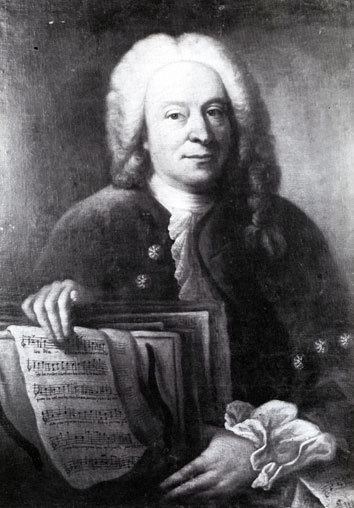Bible text Genesis 32:27 Instrumental unspecified | Vocal Double choir SATB | |
 | ||
Chorale Warum betrübst du dich, mein Herz | ||
Ich lasse dich nicht, also Ich lasse dich nicht, du segnest mich denn (I will not let you go unless you bless me), BWV Anh. 159, is a motet set for double choir. Recent scholarship assumes Johann Sebastian Bach as the composer who possibly wrote it during his Weimar period around 1712.
Contents
The piece, as it is known since the rediscovery of the collection Altbachisches Archiv in 1999, contains two movements, one for double chorus based on a text from the book Genesis in which the patriarch Jacob asks God for a blessing, followed by a closing chorale. The first movement is known as a score without author, partly in J. S. Bach's handwriting. It was attributed by Bach authorities to Johann Christoph Bach since the 19th century, while others including Philipp Spitta doubted that attribution. The chorale is one of J. S. Bach's chorale settings and was possibly added in 1802 when the motet was first printed.
Background
Bach wrote his motets in the tradition of the Evangelienmotetten (motets on gospel texts) of the 17th century by composers such as Melchior Franck, Melchior Vulpius and Heinrich Schütz. When he composed these works, music without an independent orchestra on texts limited to biblical words and a chorale without contemporary poetry, the genre was already out of fashion, but there was evidently a demand for such works at funerals, a ceremony for which at least some of Bach's motets were written.
There is scholarly debate about the exact number of motets attributable to Bach, and, as in some cases the circumstances of the first performance are not known, nor their function.
History
Ich lasse dich nicht, then known as only the first movement, was attributed in the 19th century to both Johann Sebastian Bach and Johann Christoph Bach, his father's cousin. In the Bach-Ausgabe, the editor Fritz Wüllner described the piece as "one of the most beautiful works of German church music" but not "authentic", therefore gave Johann Christoph Bach as the composer. When Wolfgang Schmieder created the Bach-Werke-Verzeichnis in 1950, he followed Wüllner, placing the motet in the appendix and assigning "presumably by Johann Christoph Bach". When Konrad Ameln edited Bach's motets for the Neue Bach-Ausgabe, he consequently omitted it, but it was printed in the appendix. Other authorities had doubted this attribution, for example Philipp Spitta, who in the first edition of his Bach biography mentioned Johann Christoph Bach as the composer, but in the second added that "the source evidence didn't permit a definite attribution".
Ich lasse dich nicht in two movements was found, written partly in Bach's hand, in the Altbachisches Archiv, a collection of music of the Bach family which the Bach scholar Christoph Wolff rediscovered in Kiev in 1999. Bach scholars now assume that J. S. Bach composed the first movement, possibly during his Weimar period around 1712. The chorale is a transcription of one of his organ pieces and was possibly added in the 19th century. John Eliot Gardiner, who recorded Bach motets including this one in 2011, comments on the authorship:
Was Bach copying or composing here? We cannot be totally sure, but from the evidence of the way the score is presented it suggests this was indeed composed by Bach, in which case it is the earliest surviving motet of his, dating from c. 1712/13, or possibly earlier, when he was employed at the Ducal court in Weimar. In terms of style it gives the impression of occupying a mid way point between that of Johann Christoph Bach and, say, Fürchte dich nicht. Indeed it feels almost like a tribute from Bach to his elder cousin whom he dubbed 'the profound composer'.
The closing chorale was not part of the score but appeared first in the first print of the motet in 1802 by Johann Gottfried Schicht, also a Thomaskantor. He found the setting in Bach's chorales collected by Carl Philip Emanuel Bach and Johann Philipp Kirnberger in 1787, transposed it from A minor to F minor and adjusted the time to the motet.
Words, scoring and structure
The text for the first movement of the motet is a verse taken from the Book of Genesis and the account of Jacob's return to Canaan, just before he is due to meet his brother Esau from whose anger he had fled many years before, after tricking his father Isaac into blessing him with the blessing belonging to the firstborn (Genesis 32:27). At night Jacob is approached by a mysterious figure who engages him in a wrestling match in which Jacob prevails, although an injury received during the fight results in a lifelong limp. Jacob insists on being blessed by the man, thought to be a theophany, before he lets go of him. The motet for double choir is followed by the third stanza of the hymn "Warum betrübst du dich, mein Herz" by Erasmus Alberus.
Bach structured the movement in F minor in two sections and scored it for double chorus, SATB – SATB and unspecified instruments playing colla parte. In the second section, the choir is no longer divided, the soprano sings the cantus firmus of the chorale, while the lower voices engage in imitative polyphony.
The added chorale in the same key is the eighth stanza from "Warum betrübst du dich, mein Herz", Dir, Jesu, Gottes Sohn, sei Preis", set for four parts. It is one of Bach's chorale settings, BWV 421, and was possibly added in the 19th century.
